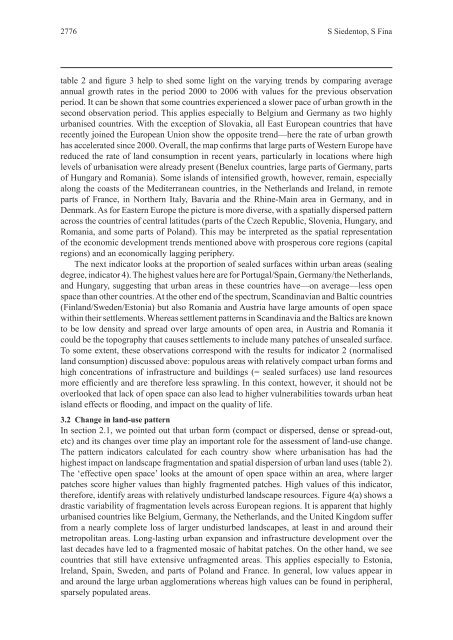PDF 20.134kB - TOBIAS-lib - Universität Tübingen
PDF 20.134kB - TOBIAS-lib - Universität Tübingen
PDF 20.134kB - TOBIAS-lib - Universität Tübingen
Sie wollen auch ein ePaper? Erhöhen Sie die Reichweite Ihrer Titel.
YUMPU macht aus Druck-PDFs automatisch weboptimierte ePaper, die Google liebt.
2776 S Siedentop, S Fina<br />
table 2 and gure 3 help to shed some light on the varying trends by comparing average<br />
annual growth rates in the period 2000 to 2006 with values for the previous observation<br />
period. It can be shown that some countries experienced a slower pace of urban growth in the<br />
second observation period. This applies especially to Belgium and Germany as two highly<br />
urbanised countries. With the exception of Slovakia, all East European countries that have<br />
recently joined the European Union show the opposite trend—here the rate of urban growth<br />
has accelerated since 2000. Overall, the map con rms that large parts of Western Europe have<br />
reduced the rate of land consumption in recent years, particularly in locations where high<br />
levels of urbanisation were already present (Benelux countries, large parts of Germany, parts<br />
of Hungary and Romania). Some islands of intensi ed growth, however, remain, especially<br />
along the coasts of the Mediterranean countries, in the Netherlands and Ireland, in remote<br />
parts of France, in Northern Italy, Bavaria and the Rhine-Main area in Germany, and in<br />
Denmark. As for Eastern Europe the picture is more diverse, with a spatially dispersed pattern<br />
across the countries of central latitudes (parts of the Czech Republic, Slovenia, Hungary, and<br />
Romania, and some parts of Poland). This may be interpreted as the spatial representation<br />
of the economic development trends mentioned above with prosperous core regions (capital<br />
regions) and an economically lagging periphery.<br />
The next indicator looks at the proportion of sealed surfaces within urban areas (sealing<br />
degree, indicator 4). The highest values here are for Portugal/Spain, Germany/the Netherlands,<br />
and Hungary, suggesting that urban areas in these countries have—on average—less open<br />
space than other countries. At the other end of the spectrum, Scandinavian and Baltic countries<br />
(Finland/Sweden/Estonia) but also Romania and Austria have large amounts of open space<br />
within their settlements. Whereas settlement patterns in Scandinavia and the Baltics are known<br />
to be low density and spread over large amounts of open area, in Austria and Romania it<br />
could be the topography that causes settlements to include many patches of unsealed surface.<br />
To some extent, these observations correspond with the results for indicator 2 (normalised<br />
land consumption) discussed above: populous areas with relatively compact urban forms and<br />
high concentrations of infrastructure and buildings (= sealed surfaces) use land resources<br />
more ef ciently and are therefore less sprawling. In this context, however, it should not be<br />
overlooked that lack of open space can also lead to higher vulnerabilities towards urban heat<br />
island effects or ooding, and impact on the quality of life.<br />
3.2 Change in land-use pattern<br />
In section 2.1, we pointed out that urban form (compact or dispersed, dense or spread-out,<br />
etc) and its changes over time play an important role for the assessment of land-use change.<br />
The pattern indicators calculated for each country show where urbanisation has had the<br />
highest impact on landscape fragmentation and spatial dispersion of urban land uses (table 2).<br />
The ‘effective open space’ looks at the amount of open space within an area, where larger<br />
patches score higher values than highly fragmented patches. High values of this indicator,<br />
therefore, identify areas with relatively undisturbed landscape resources. Figure 4(a) shows a<br />
drastic variability of fragmentation levels across European regions. It is apparent that highly<br />
urbanised countries like Belgium, Germany, the Netherlands, and the United Kingdom suffer<br />
from a nearly complete loss of larger undisturbed landscapes, at least in and around their<br />
metropolitan areas. Long-lasting urban expansion and infrastructure development over the<br />
last decades have led to a fragmented mosaic of habitat patches. On the other hand, we see<br />
countries that still have extensive unfragmented areas. This applies especially to Estonia,<br />
Ireland, Spain, Sweden, and parts of Poland and France. In general, low values appear in<br />
and around the large urban agglomerations whereas high values can be found in peripheral,<br />
sparsely populated areas.

















